Home / Reactions of Sugars: Glycosylation and Protection
Carbohydrates
Reactions of Sugars: Glycosylation and Protection
Last updated: September 19th, 2022 |
Finally, Some Reactions Of Sugars: Glycosylation And Protection
In this post we introduce some simple reactions of sugars, especially glycosylation and protection:
- Formation of “glycosides” – just a different name for acetals when they exist at the “anomeric” carbon of sugars
- Hydrolysis of glycosidic bonds (glycosides), which is exactly like hydrolysis of acetals (aqueous acid)
- Reactions on the -OH groups of sugars, including protecting groups
- How to “deprotect” the anomeric (C-1) carbon selectively
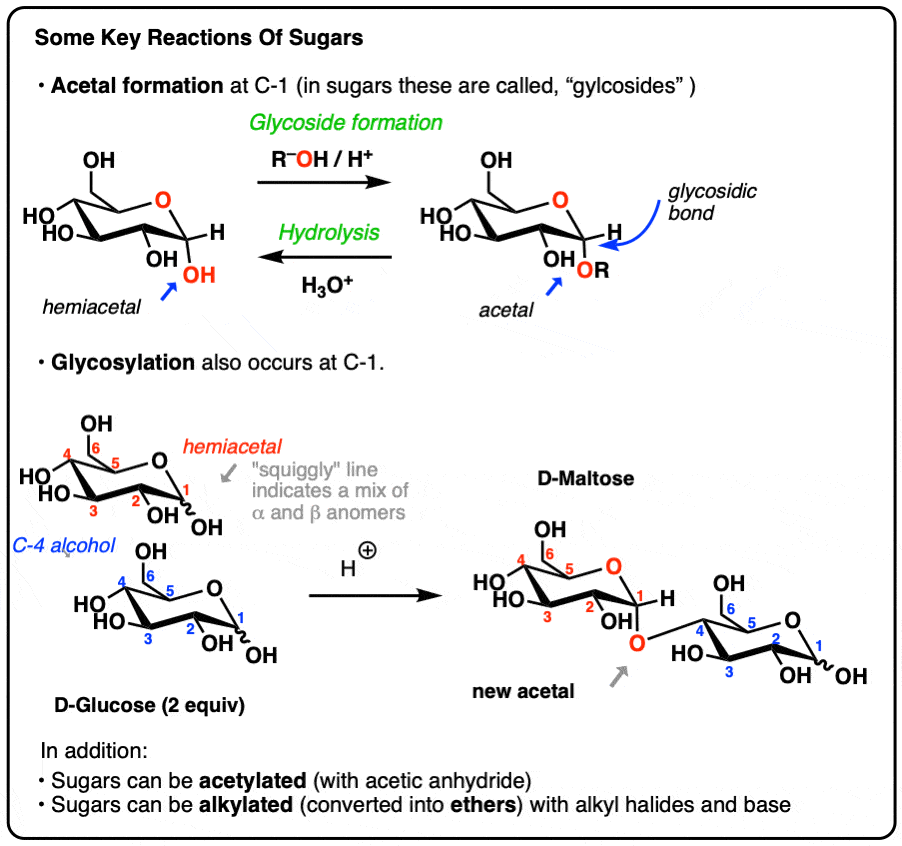
Table of Contents
- Carbohydrates and Sugars: Finally, Some Reactions!
- Reactions At The Hemiacetal (Anomeric) Carbon: Formation And Hydrolysis Of “Glycosides”
- Hydrolysis of Glycosides with Aqueous Acid
- Formation of Disaccharides (In Theory, If Not In Practice)
- Hydrolysis of The Glycosidic Bond Of Disaccharides
- Reactions Of The Alcohol Groups Of Sugars: The Problem Of Selectivity
- A Brute Force Way Around Selectivity: Excess Reagent
- Ethers At C-1 (The Anomeric Carbon) Can Be Cleaved Selectively
- How To Get Around The Selectivity Problem? A Glimpse Into Org 3
- Notes
- (Advanced) References and Further Reading
1. Carbohydrates and Sugars: Finally, Some Reactions!
If reactions are the meat of an organic chemistry course, then nomenclature is the bun – and you’d be forgiven for thinking that the content in this chapter on sugars has been a little, er, “carb-heavy” so far.
A lot of nomenclature and not many reactions!
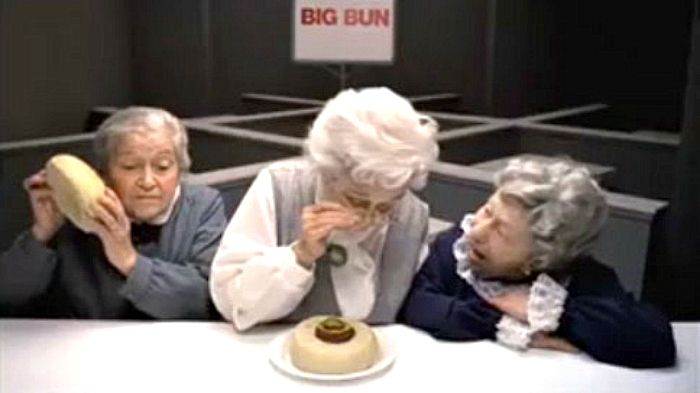
We’re going to try to fix this deficiency in our chemistry diet today with a discussion of the key reactions of sugars.
The reactions of sugars we will cover really boil down to two main categories.
Part 1: Reactions of the anomeric (hemiacetal) carbon
The anomeric carbon of a sugar can form and break acetals. That’s about it.
- Formation of acetals (“glycosides”), including disaccharides and polysaccharides
- Hydrolysis (cleavage) of acetals (“glycosides”)
Part 2: Reactions of carbohydrate hydroxy groups (alcohols)
The hydroxy groups of sugars can perform all the reactions of alcohols (e.g. ether formation). The trick is getting the right one to react! d
- Ether formation (non-selective, except in special cases with the primary (C6) alcohol)
- Ester (acetate) formation (non-selective) with Ac2O.
We’ll finish up with a few remarks about how reactions of carbohydrates really take us to the limits of what we study in “Org 2” and how it points the way to “Org 3”.
2. Reactions At The Hemiacetal (“Anomeric”) Carbon: Formation Of Glycosides
A few chapters ago, we saw how to convert aldehydes and ketones to acetals, via hemiacetals. In the forward direction, this is accomplished by treating the ketone (or aldehyde) with an excess of alcohol in the presence of acid (such as H2SO4).

Simple sugars (e.g., D-Glucose) have a hemiacetal functional group due to the fact that 5- and 6- membered rings readily form between the carbonyl carbon and the hydroxyl groups, a phenomenon known as “ring-chain tautomerism“.
So, the hemiacetal functional group on sugars can also be converted into a full acetal by treatment with an alcohol in the presence of acid.
In carbohydrate chemistry, these acetals have a special name: “glycosides“.
Here’s an example. Treating D-glucose with ethanol and acid provides a product called Ethyl -D-glucopyranoside.
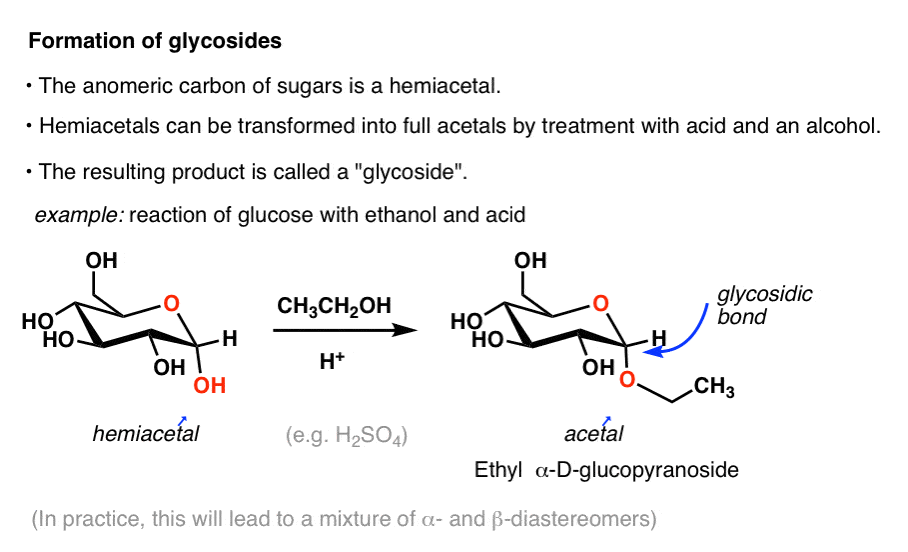
The new C–O bond is called a “glycosidic bond”. In the drawing above, we drew only one anomer (the α), but in practice both will form.
Formation of the glycoside “locks” the ring closed, and it is no longer in equilibrium with the open-chain form, and is therefore no longer a “reducing sugar” [see: Reducing Sugars]. Like all acetals, about the only reaction of significance that it will undergo is hydrolysis back to the starting material with aqueous acid.
3. Hydrolysis of Glycosides With Aqueous Acid
So treatment of a glycoside with water and acid results in the original sugar (as a mixture of anomers, which we can describe with a “squiggly line”).
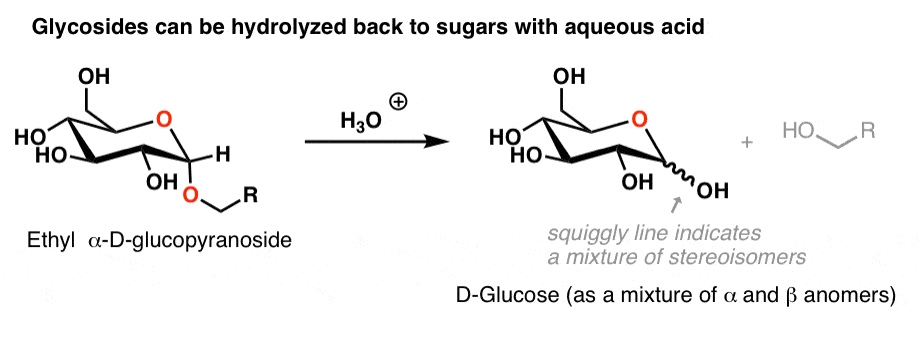
4. Formation Of Disaccharides (In Theory, If Not In Practice)
A particularly important type of glycoside are those formed from the combination of two or more sugars. Maltose, for example, is the acetal formed when C-1 of D-glucose reacts with the C4-OH of another molecule of D-glucose to form an α- glycosidic linkage.
A quick way of describing this linkage is (α-1→4), where 1 and 4 indicate the numbers of the carbons flanking the glycosidic bond, and “α” indicates the stereochemistry at the anomeric carbon. [quick review of alpha and beta]
In theory, it’s possible to carry out this reaction by treating D-glucose with acid:
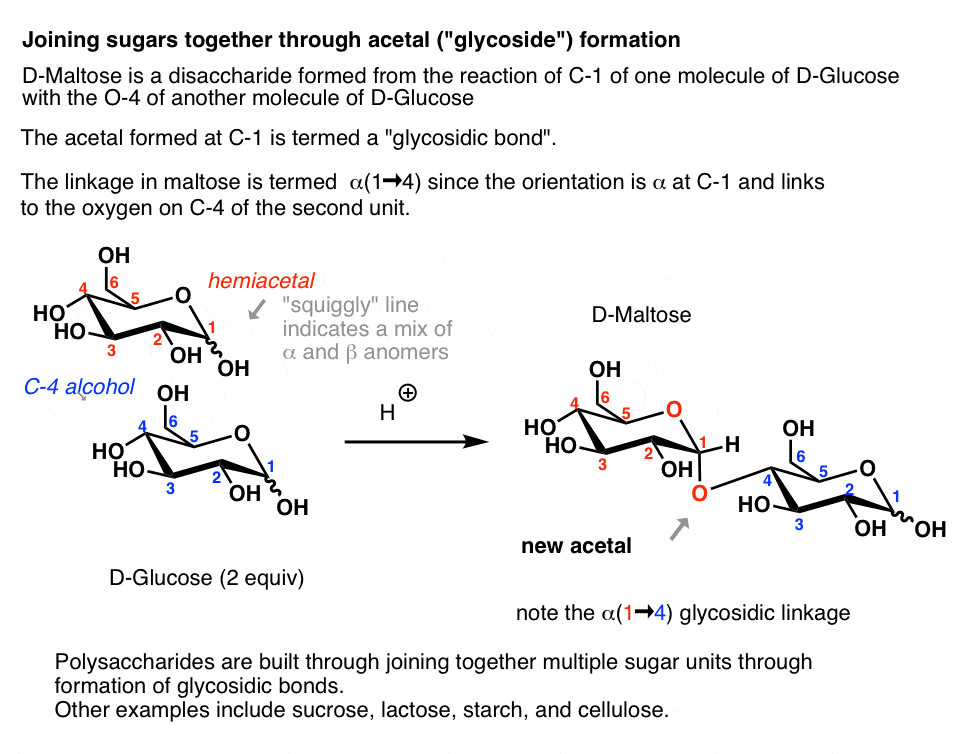
[To see the mechanism hover here for a pop-up image or click on link for image.
In practice? Well, the drawing above is a bit misleading.
In the lab, adding acid to glucose might get you some maltose, but it will also deliver a ton of other side-products from the reaction of other hydroxy groups (C1-OH, C2-OH, etc.) with the C-1 carbon. (it’s the kind of reaction my friend Jeff would write in his lab notebook as “BFM”, where “M” stands for “mess”).
In nature, very specific enzymes have evolved that combine sugars together with exquisite site-selectivity (“regioselectivity” for C4-OH in this case, versus the other possible alcohols as nucleophiles) and stereoselectivity (α- for maltose).
[For example, it’s very important that the orientation at the C-1 acetal is drawn alpha (α) for maltose. The beta (β) stereoisomer is another disaccharide entirely (cellobiose).]
Similarly:
- sucrose (table sugar) is a disaccharide formed through acetal formation between C-1 of glucose and C-2 of fructose (α-1→β-2 linkage)
- lactose is a disaccharide formed between C-1 of galactose and C4-OH of glucose (β-1→4 linkage).
- Amylose, one of the two components of starch, is a polysaccharide of glucose linked through (α-1→4) glycosidic bonds.
All are built through formation of glycosidic bonds between sugars – in other words, good-old acetal formation.
5. Hydrolysis of The Glycosidic Bond of Disaccharides
Just as with ethyl D-glucopyranoside, above, adding aqueous acid to a polysaccharide will hydrolyze it back into the constitutent sugars.
D-lactose, for instance, can be hydrolyzed back into D-Galactose and D-Glucose with aqueous acid:

In organisms, enzymes perform the hydrolysis of glycosides – these are called glycosidases . The familiar condition of “lactose intolerance” is a result of the body lacking the necessary enzyme (lactase) to break down the glycosidic bond of lactose.
Enzymes can be exquisitely sensitive to stereochemistry. Starch, a polymer of glucose with (α-1→4) glycosidic bonds, is easily broken down in our bodies to units of D-Glucose, but cellulose [with (β-1→4) glucose linkages] is not. [Fun fact: Grass-eating mammals like cows rely on microorganisms in their gut to convert cellulose to glucose].
6. Reactions Of The Alcohol Groups Of Sugars: The Problem Of Selectivity
What kind of reactions do the hydroxy groups of sugars undergo? They’re essentially just alcohols, right?
We’ve explored many important reactions of alcohols previously. So let’s say we wanted to do a meat-and-potatoes reaction of alcohols – the Williamson Ether synthesis – on the C3-OH of glucose.
You may recall that to perform a Williamson, all we need to do is add base and an alkyl halide, and voila – an ether forms.
What could possibly go wrong?

Well, at least four things could go wrong, actually. The C-3 OH isn’t significantly more selective toward CH3I than any of the other four hydroxyl groups.

The result is a mixture of products which requires a tedious separation.
Even with all the advances of modern organic chemistry, there’s no known way to get the Williamson ether synthesis to occur selectively with, say, the C3-OH of glucose in good yields without also forming ethers at the other hydroxyl groups.
This might seem hard to believe but it is true. The more we learn about organic chemistry, the more we learn to appreciate just how incredible Nature is in devising extremely selective catalysts for reactions on sugars at specific sites without the use of protecting groups.
There’s still lots to discover in organic chemistry!
[There is one reliable way to put a single ether group on a sugar like glucose. The C6-OH is a primary alcohol, and therefore less sterically hindered than the other alcohol groups. It is possible to use a very bulky alkyl halide like trityl chloride and have it react selectively there. See Note 1 ]
No matter what reaction you try – oxidation, acetylation, halogenation, or silylation – you’ll almost always run into this problem with unprotected sugars. A workaround is in order. [Note 2]
7. A Brute Force Way Around Selectivity: Use Excess Reagent
If we abandon all hopes of selectivity, good yields can be obtained by just treating the sugar with a vast excess of a given reagent. For example if we treat glucose with excess methyl iodide in the presence of base, we get the penta-ether in high yield. [We sometimes call this, “exhaustive methylation”]. [Note 3]
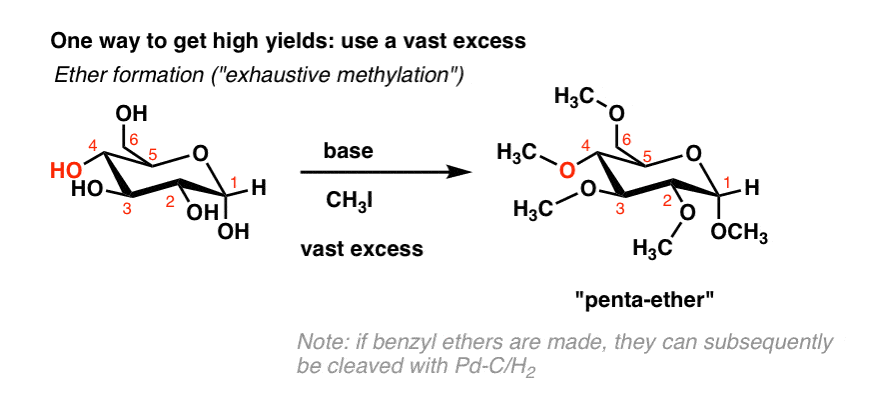
Using an excess of acetic anhydride, one can also form the “penta-acetate”:
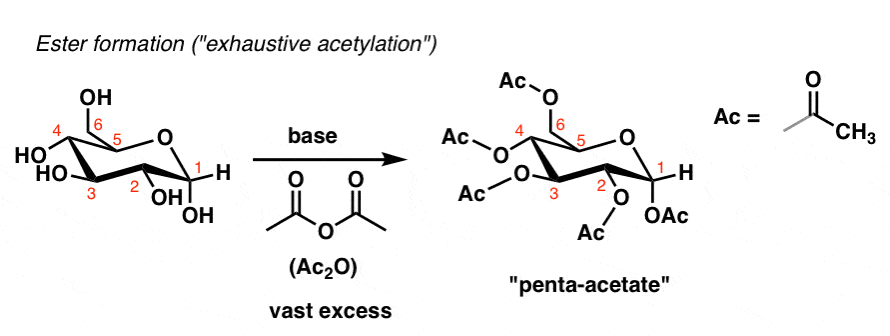
Some very familiar plastics from modern life are the result of treating the polysaccharide cellulose with various reagents under “exhaustive” conditions:
- Cellulose acetate film (“safety film”, from treating cellulose with excess acetic anhydride)
- Celluloid (the first plastic, originally used as film stock, obtained through nitration of cellulose)
- Rayon (where cellulose is treated with excess carbon disulfide to form xanthates)
8. Ethers At C-1 (The Anomeric Carbon) Can Be Cleaved Selectively
One note. It’s possible to free up the C-1 hydroxyl group on the penta-ether through acidic hydrolysis, because the anomeric carbon (C-1) is part of an acetal.
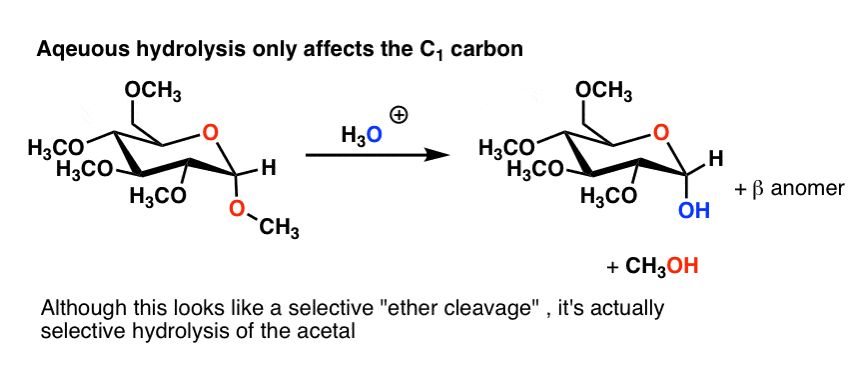
This might look like an ether cleavage (which usually requires a very harsh acid like H-I) but is actually just hydrolysis of an acetal. (A good “trick” exam question!).
9. How To Get Around The Selectivity Problem?
Until we develop catalysts that rival enzymes in their ability to react selectively with the hydroxyl groups of sugars, we’re left with protecting group strategies.
We briefly covered protecting groups in the chapter on alcohols. [see: “Protecting Groups For Alcohols“] With sugars, protecting group strategies are taken to a whole new level. It’s a big topic – one we don’t have time for in this post today. [Here is a start, though.]
A Glimpse Into The Land Beyond (Org 3)
I’d argue that protecting group strategies of sugars is really a topic for what you might call “Org 3”.
What does that mean?
Org 1 and Org 2 are courses that introduce the properties of the various functional groups and their major reactions. The functional groups are largely treated in isolation.
It’s a bit like chess. Org 1 and Org 2 is like learning the rules of how the game is played, and how the pieces (functional groups) move.
In Org 3, life gets more complicated. We learn how to devise strategies to deal with the many real-life situations where a molecule has multiple reactive functional groups (like glucose!) , and we need to selectively form a bond at just one of them.
Or, in chess terms, it’s where you start to learn how to coordinate all your pieces together in an overall strategy.
In the meantime, I hope this post has been more beef and less bun.
Notes
Related Articles
The trityl group (triphenylmethyl) is so frickin’ massive that it tends only to fit on primary alcohols, so it will react selectively with the C-6 hydroxyl group:
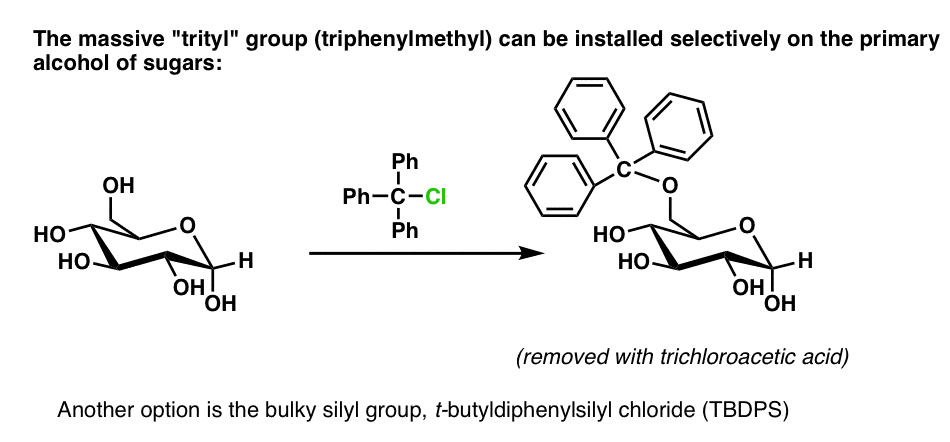
I can say from experience that it also feels really good after you put it on, since the mass of your product skyrockets (“started with 400 mgs, and now I almost have a gram. YESSS!”). This feeling disappears, however, when it’s removed with trichloroacetic acid. Another option is the bulky silyl group t-butyldiphenylsilyl chloride (TBDPS).
Note 2. This is way above Org 2, but here’s a very useful protection sequence that allows for selective functionalization of C-3 of D-glucose. Treatment with acetone and acid (one can also use a Lewis acid, like CuSO4) ties up 4 of the 5 hydroxyl groups as “acetonides” (acetals of acetone). This leaves the C-3 OH, which can then be selectively methylated, if desired. [This was used in the Nicolaou synthesis of Leucomycin A to put a methyl ether on C-3 of glucose. See “Adventures In Carbohydrate Chemistry” for many more wonderful examples. ]
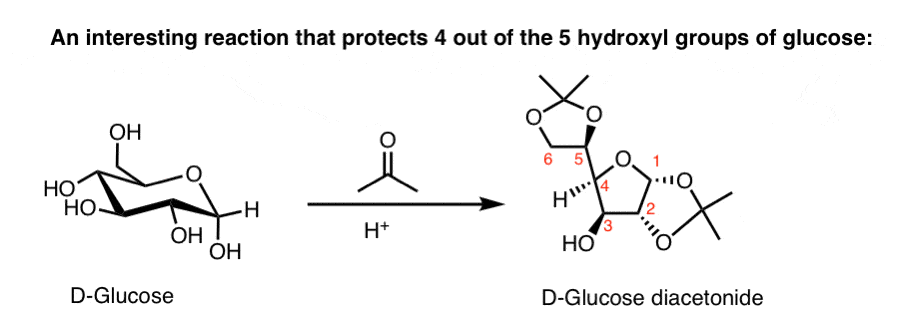
Note 3. A more reversible variant of this reaction forms benzyl ethers instead of methyl ethers (which can be notoriously difficult to cleave). The benzyl ethers can be removed by treatment with Pd/C and hydrogen gas.
(Advanced) References and Further Reading
- Esterification of the primary alcoholic groups of carbohydrates with acetic acid: a general reaction
R. B. Duff
J. Chem. Soc., 1957, 4730-4734
DOI: 10.1039/JR9570004730
An early paper showing that selective monoacetylation on the primary hydroxyl is possible, since that is significantly more reactive. - Exhaustive Methylation of Glucosamine
Norbert J. Wojciechowski, Ralph Daniels, and Bernard Ecanow
Pharm. Sci. 1961, 50 (10), 888-889
DOI: 10.1002/jps.2600501024
The abstract states: “A reported synthesis of a glucosamine quaternary derivative was investigated by chemical and infrared spectra methods. Under the conditions reported the glucosamine was found to become degraded and tetramethylammonium iodide was formed” - Applications of Tin-Containing Intermediates to Carbohydrate Chemistry
Bruce Grindley
Adv. Carbohydrate Chem. and Biochem. 1998, 53, 17-142
DOI: 10.1016/S0065-2318(08)60043-8
The regioselective acylation and alkylation of tin acetals is very useful for the selective protection of a number of polyol containing systems, including protection of equatorial over axial hydroxyl groups and for differentiation between two equatorial hydroxyl groups with different steric environments. - Adventures in Carbohydrate Chemistry: New Synthetic Technologies, Chemical Synthesis, Molecular Design, and Chemical Biology
K. C. Nicolaou Prof. Dr. Helen J. Mitchell Dr.
Angew. Chem. Int. Ed. 2001, 40 (9), 1576-1624
DOI: 10.1002/1521-3773(20010504)40:9
A tour de force review by Prof. K. C. Nicolaou (now at Rice U.) that exhaustively covers carbohydrate chemistry and its applications in natural product total synthesis.
00 General Chemistry Review
01 Bonding, Structure, and Resonance
- How Do We Know Methane (CH4) Is Tetrahedral?
- Hybrid Orbitals and Hybridization
- How To Determine Hybridization: A Shortcut
- Orbital Hybridization And Bond Strengths
- Sigma bonds come in six varieties: Pi bonds come in one
- A Key Skill: How to Calculate Formal Charge
- The Four Intermolecular Forces and How They Affect Boiling Points
- 3 Trends That Affect Boiling Points
- How To Use Electronegativity To Determine Electron Density (and why NOT to trust formal charge)
- Introduction to Resonance
- How To Use Curved Arrows To Interchange Resonance Forms
- Evaluating Resonance Forms (1) - The Rule of Least Charges
- How To Find The Best Resonance Structure By Applying Electronegativity
- Evaluating Resonance Structures With Negative Charges
- Evaluating Resonance Structures With Positive Charge
- Exploring Resonance: Pi-Donation
- Exploring Resonance: Pi-acceptors
- In Summary: Evaluating Resonance Structures
- Drawing Resonance Structures: 3 Common Mistakes To Avoid
- How to apply electronegativity and resonance to understand reactivity
- Bond Hybridization Practice
- Structure and Bonding Practice Quizzes
- Resonance Structures Practice
02 Acid Base Reactions
- Introduction to Acid-Base Reactions
- Acid Base Reactions In Organic Chemistry
- The Stronger The Acid, The Weaker The Conjugate Base
- Walkthrough of Acid-Base Reactions (3) - Acidity Trends
- Five Key Factors That Influence Acidity
- Acid-Base Reactions: Introducing Ka and pKa
- How to Use a pKa Table
- The pKa Table Is Your Friend
- A Handy Rule of Thumb for Acid-Base Reactions
- Acid Base Reactions Are Fast
- pKa Values Span 60 Orders Of Magnitude
- How Protonation and Deprotonation Affect Reactivity
- Acid Base Practice Problems
03 Alkanes and Nomenclature
- Meet the (Most Important) Functional Groups
- Condensed Formulas: Deciphering What the Brackets Mean
- Hidden Hydrogens, Hidden Lone Pairs, Hidden Counterions
- Don't Be Futyl, Learn The Butyls
- Primary, Secondary, Tertiary, Quaternary In Organic Chemistry
- Branching, and Its Affect On Melting and Boiling Points
- The Many, Many Ways of Drawing Butane
- Wedge And Dash Convention For Tetrahedral Carbon
- Common Mistakes in Organic Chemistry: Pentavalent Carbon
- Table of Functional Group Priorities for Nomenclature
- Summary Sheet - Alkane Nomenclature
- Organic Chemistry IUPAC Nomenclature Demystified With A Simple Puzzle Piece Approach
- Boiling Point Quizzes
- Organic Chemistry Nomenclature Quizzes
04 Conformations and Cycloalkanes
- Staggered vs Eclipsed Conformations of Ethane
- Conformational Isomers of Propane
- Newman Projection of Butane (and Gauche Conformation)
- Introduction to Cycloalkanes
- Geometric Isomers In Small Rings: Cis And Trans Cycloalkanes
- Calculation of Ring Strain In Cycloalkanes
- Cycloalkanes - Ring Strain In Cyclopropane And Cyclobutane
- Cyclohexane Conformations
- Cyclohexane Chair Conformation: An Aerial Tour
- How To Draw The Cyclohexane Chair Conformation
- The Cyclohexane Chair Flip
- The Cyclohexane Chair Flip - Energy Diagram
- Substituted Cyclohexanes - Axial vs Equatorial
- Ranking The Bulkiness Of Substituents On Cyclohexanes: "A-Values"
- Cyclohexane Chair Conformation Stability: Which One Is Lower Energy?
- Fused Rings - Cis-Decalin and Trans-Decalin
- Naming Bicyclic Compounds - Fused, Bridged, and Spiro
- Bredt's Rule (And Summary of Cycloalkanes)
- Newman Projection Practice
- Cycloalkanes Practice Problems
05 A Primer On Organic Reactions
- The Most Important Question To Ask When Learning a New Reaction
- Curved Arrows (for reactions)
- Nucleophiles and Electrophiles
- The Three Classes of Nucleophiles
- Nucleophilicity vs. Basicity
- What Makes A Good Nucleophile?
- What Makes A Good Leaving Group?
- 3 Factors That Stabilize Carbocations
- Equilibrium and Energy Relationships
- 7 Factors that stabilize negative charge in organic chemistry
- 7 Factors That Stabilize Positive Charge in Organic Chemistry
- What's a Transition State?
- Hammond's Postulate
- Learning Organic Chemistry Reactions: A Checklist (PDF)
- Introduction to Oxidative Cleavage Reactions
06 Free Radical Reactions
- Free Radical Reactions
- 3 Factors That Stabilize Free Radicals
- Bond Strengths And Radical Stability
- Free Radical Initiation: Why Is "Light" Or "Heat" Required?
- Initiation, Propagation, Termination
- Monochlorination Products Of Propane, Pentane, And Other Alkanes
- Selectivity In Free Radical Reactions
- Selectivity in Free Radical Reactions: Bromination vs. Chlorination
- Halogenation At Tiffany's
- Allylic Bromination
- Bonus Topic: Allylic Rearrangements
- In Summary: Free Radicals
- Synthesis (2) - Reactions of Alkanes
- Free Radicals Practice Quizzes
07 Stereochemistry and Chirality
- Types of Isomers: Constitutional Isomers, Stereoisomers, Enantiomers, and Diastereomers
- How To Draw The Enantiomer Of A Chiral Molecule
- How To Draw A Bond Rotation
- Introduction to Assigning (R) and (S): The Cahn-Ingold-Prelog Rules
- Assigning Cahn-Ingold-Prelog (CIP) Priorities (2) - The Method of Dots
- Enantiomers vs Diastereomers vs The Same? Two Methods For Solving Problems
- Assigning R/S To Newman Projections (And Converting Newman To Line Diagrams)
- How To Determine R and S Configurations On A Fischer Projection
- The Meso Trap
- Optical Rotation, Optical Activity, and Specific Rotation
- Optical Purity and Enantiomeric Excess
- What's a Racemic Mixture?
- Chiral Allenes And Chiral Axes
- Stereochemistry Practice Problems and Quizzes
08 Substitution Reactions
- Nucleophilic Substitution Reactions - Introduction
- Two Types of Nucleophilic Substitution Reactions
- The SN2 Mechanism
- Why the SN2 Reaction Is Powerful
- The SN1 Mechanism
- The Conjugate Acid Is A Better Leaving Group
- Comparing the SN1 and SN2 Reactions
- Polar Protic? Polar Aprotic? Nonpolar? All About Solvents
- Steric Hindrance is Like a Fat Goalie
- Common Blind Spot: Intramolecular Reactions
- Substitution Practice - SN1
- Substitution Practice - SN2
09 Elimination Reactions
- Elimination Reactions (1): Introduction And The Key Pattern
- Elimination Reactions (2): The Zaitsev Rule
- Elimination Reactions Are Favored By Heat
- Two Elimination Reaction Patterns
- The E1 Reaction
- The E2 Mechanism
- E1 vs E2: Comparing the E1 and E2 Reactions
- Antiperiplanar Relationships: The E2 Reaction and Cyclohexane Rings
- Bulky Bases in Elimination Reactions
- Comparing the E1 vs SN1 Reactions
- Elimination (E1) Reactions With Rearrangements
- E1cB - Elimination (Unimolecular) Conjugate Base
- Elimination (E1) Practice Problems And Solutions
- Elimination (E2) Practice Problems and Solutions
10 Rearrangements
11 SN1/SN2/E1/E2 Decision
- Identifying Where Substitution and Elimination Reactions Happen
- Deciding SN1/SN2/E1/E2 (1) - The Substrate
- Deciding SN1/SN2/E1/E2 (2) - The Nucleophile/Base
- SN1 vs E1 and SN2 vs E2 : The Temperature
- Deciding SN1/SN2/E1/E2 - The Solvent
- Wrapup: The Key Factors For Determining SN1/SN2/E1/E2
- Alkyl Halide Reaction Map And Summary
- SN1 SN2 E1 E2 Practice Problems
12 Alkene Reactions
- E and Z Notation For Alkenes (+ Cis/Trans)
- Alkene Stability
- Alkene Addition Reactions: "Regioselectivity" and "Stereoselectivity" (Syn/Anti)
- Stereoselective and Stereospecific Reactions
- Hydrohalogenation of Alkenes and Markovnikov's Rule
- Hydration of Alkenes With Aqueous Acid
- Rearrangements in Alkene Addition Reactions
- Halogenation of Alkenes and Halohydrin Formation
- Oxymercuration Demercuration of Alkenes
- Hydroboration Oxidation of Alkenes
- m-CPBA (meta-chloroperoxybenzoic acid)
- OsO4 (Osmium Tetroxide) for Dihydroxylation of Alkenes
- Palladium on Carbon (Pd/C) for Catalytic Hydrogenation of Alkenes
- Cyclopropanation of Alkenes
- A Fourth Alkene Addition Pattern - Free Radical Addition
- Alkene Reactions: Ozonolysis
- Summary: Three Key Families Of Alkene Reaction Mechanisms
- Synthesis (4) - Alkene Reaction Map, Including Alkyl Halide Reactions
- Alkene Reactions Practice Problems
13 Alkyne Reactions
- Acetylides from Alkynes, And Substitution Reactions of Acetylides
- Partial Reduction of Alkynes With Lindlar's Catalyst
- Partial Reduction of Alkynes With Na/NH3 To Obtain Trans Alkenes
- Alkyne Hydroboration With "R2BH"
- Hydration and Oxymercuration of Alkynes
- Hydrohalogenation of Alkynes
- Alkyne Halogenation: Bromination and Chlorination of Alkynes
- Oxidation of Alkynes With O3 and KMnO4
- Alkenes To Alkynes Via Halogenation And Elimination Reactions
- Alkynes Are A Blank Canvas
- Synthesis (5) - Reactions of Alkynes
- Alkyne Reactions Practice Problems With Answers
14 Alcohols, Epoxides and Ethers
- Alcohols - Nomenclature and Properties
- Alcohols Can Act As Acids Or Bases (And Why It Matters)
- Alcohols - Acidity and Basicity
- The Williamson Ether Synthesis
- Ethers From Alkenes, Tertiary Alkyl Halides and Alkoxymercuration
- Alcohols To Ethers via Acid Catalysis
- Cleavage Of Ethers With Acid
- Epoxides - The Outlier Of The Ether Family
- Opening of Epoxides With Acid
- Epoxide Ring Opening With Base
- Making Alkyl Halides From Alcohols
- Tosylates And Mesylates
- PBr3 and SOCl2
- Elimination Reactions of Alcohols
- Elimination of Alcohols To Alkenes With POCl3
- Alcohol Oxidation: "Strong" and "Weak" Oxidants
- Demystifying The Mechanisms of Alcohol Oxidations
- Protecting Groups For Alcohols
- Thiols And Thioethers
- Calculating the oxidation state of a carbon
- Oxidation and Reduction in Organic Chemistry
- Oxidation Ladders
- SOCl2 Mechanism For Alcohols To Alkyl Halides: SN2 versus SNi
- Alcohol Reactions Roadmap (PDF)
- Alcohol Reaction Practice Problems
- Epoxide Reaction Quizzes
- Oxidation and Reduction Practice Quizzes
15 Organometallics
- What's An Organometallic?
- Formation of Grignard and Organolithium Reagents
- Organometallics Are Strong Bases
- Reactions of Grignard Reagents
- Protecting Groups In Grignard Reactions
- Synthesis Problems Involving Grignard Reagents
- Grignard Reactions And Synthesis (2)
- Organocuprates (Gilman Reagents): How They're Made
- Gilman Reagents (Organocuprates): What They're Used For
- The Heck, Suzuki, and Olefin Metathesis Reactions (And Why They Don't Belong In Most Introductory Organic Chemistry Courses)
- Reaction Map: Reactions of Organometallics
- Grignard Practice Problems
16 Spectroscopy
- Degrees of Unsaturation (or IHD, Index of Hydrogen Deficiency)
- Conjugation And Color (+ How Bleach Works)
- Introduction To UV-Vis Spectroscopy
- UV-Vis Spectroscopy: Absorbance of Carbonyls
- UV-Vis Spectroscopy: Practice Questions
- Bond Vibrations, Infrared Spectroscopy, and the "Ball and Spring" Model
- Infrared Spectroscopy: A Quick Primer On Interpreting Spectra
- IR Spectroscopy: 4 Practice Problems
- 1H NMR: How Many Signals?
- Homotopic, Enantiotopic, Diastereotopic
- Diastereotopic Protons in 1H NMR Spectroscopy: Examples
- 13-C NMR - How Many Signals
- Liquid Gold: Pheromones In Doe Urine
- Natural Product Isolation (1) - Extraction
- Natural Product Isolation (2) - Purification Techniques, An Overview
- Structure Determination Case Study: Deer Tarsal Gland Pheromone
17 Dienes and MO Theory
- What To Expect In Organic Chemistry 2
- Are these molecules conjugated?
- Conjugation And Resonance In Organic Chemistry
- Bonding And Antibonding Pi Orbitals
- Molecular Orbitals of The Allyl Cation, Allyl Radical, and Allyl Anion
- Pi Molecular Orbitals of Butadiene
- Reactions of Dienes: 1,2 and 1,4 Addition
- Thermodynamic and Kinetic Products
- More On 1,2 and 1,4 Additions To Dienes
- s-cis and s-trans
- The Diels-Alder Reaction
- Cyclic Dienes and Dienophiles in the Diels-Alder Reaction
- Stereochemistry of the Diels-Alder Reaction
- Exo vs Endo Products In The Diels Alder: How To Tell Them Apart
- HOMO and LUMO In the Diels Alder Reaction
- Why Are Endo vs Exo Products Favored in the Diels-Alder Reaction?
- Diels-Alder Reaction: Kinetic and Thermodynamic Control
- The Retro Diels-Alder Reaction
- The Intramolecular Diels Alder Reaction
- Regiochemistry In The Diels-Alder Reaction
- The Cope and Claisen Rearrangements
- Electrocyclic Reactions
- Electrocyclic Ring Opening And Closure (2) - Six (or Eight) Pi Electrons
- Diels Alder Practice Problems
- Molecular Orbital Theory Practice
18 Aromaticity
- Introduction To Aromaticity
- Rules For Aromaticity
- Huckel's Rule: What Does 4n+2 Mean?
- Aromatic, Non-Aromatic, or Antiaromatic? Some Practice Problems
- Antiaromatic Compounds and Antiaromaticity
- The Pi Molecular Orbitals of Benzene
- The Pi Molecular Orbitals of Cyclobutadiene
- Frost Circles
- Aromaticity Practice Quizzes
19 Reactions of Aromatic Molecules
- Electrophilic Aromatic Substitution: Introduction
- Activating and Deactivating Groups In Electrophilic Aromatic Substitution
- Electrophilic Aromatic Substitution - The Mechanism
- Ortho-, Para- and Meta- Directors in Electrophilic Aromatic Substitution
- Understanding Ortho, Para, and Meta Directors
- Why are halogens ortho- para- directors?
- Disubstituted Benzenes: The Strongest Electron-Donor "Wins"
- Electrophilic Aromatic Substitutions (1) - Halogenation of Benzene
- Electrophilic Aromatic Substitutions (2) - Nitration and Sulfonation
- EAS Reactions (3) - Friedel-Crafts Acylation and Friedel-Crafts Alkylation
- Intramolecular Friedel-Crafts Reactions
- Nucleophilic Aromatic Substitution (NAS)
- Nucleophilic Aromatic Substitution (2) - The Benzyne Mechanism
- Reactions on the "Benzylic" Carbon: Bromination And Oxidation
- The Wolff-Kishner, Clemmensen, And Other Carbonyl Reductions
- More Reactions on the Aromatic Sidechain: Reduction of Nitro Groups and the Baeyer Villiger
- Aromatic Synthesis (1) - "Order Of Operations"
- Synthesis of Benzene Derivatives (2) - Polarity Reversal
- Aromatic Synthesis (3) - Sulfonyl Blocking Groups
- Birch Reduction
- Synthesis (7): Reaction Map of Benzene and Related Aromatic Compounds
- Aromatic Reactions and Synthesis Practice
- Electrophilic Aromatic Substitution Practice Problems
20 Aldehydes and Ketones
- What's The Alpha Carbon In Carbonyl Compounds?
- Nucleophilic Addition To Carbonyls
- Aldehydes and Ketones: 14 Reactions With The Same Mechanism
- Sodium Borohydride (NaBH4) Reduction of Aldehydes and Ketones
- Grignard Reagents For Addition To Aldehydes and Ketones
- Wittig Reaction
- Hydrates, Hemiacetals, and Acetals
- Imines - Properties, Formation, Reactions, and Mechanisms
- All About Enamines
- Breaking Down Carbonyl Reaction Mechanisms: Reactions of Anionic Nucleophiles (Part 2)
- Aldehydes Ketones Reaction Practice
21 Carboxylic Acid Derivatives
- Nucleophilic Acyl Substitution (With Negatively Charged Nucleophiles)
- Addition-Elimination Mechanisms With Neutral Nucleophiles (Including Acid Catalysis)
- Basic Hydrolysis of Esters - Saponification
- Transesterification
- Proton Transfer
- Fischer Esterification - Carboxylic Acid to Ester Under Acidic Conditions
- Lithium Aluminum Hydride (LiAlH4) For Reduction of Carboxylic Acid Derivatives
- LiAlH[Ot-Bu]3 For The Reduction of Acid Halides To Aldehydes
- Di-isobutyl Aluminum Hydride (DIBAL) For The Partial Reduction of Esters and Nitriles
- Amide Hydrolysis
- Thionyl Chloride (SOCl2) And Conversion of Carboxylic Acids to Acid Halides
- Diazomethane (CH2N2)
- Carbonyl Chemistry: Learn Six Mechanisms For the Price Of One
- Making Music With Mechanisms (PADPED)
- Carboxylic Acid Derivatives Practice Questions
22 Enols and Enolates
- Keto-Enol Tautomerism
- Enolates - Formation, Stability, and Simple Reactions
- Kinetic Versus Thermodynamic Enolates
- Aldol Addition and Condensation Reactions
- Reactions of Enols - Acid-Catalyzed Aldol, Halogenation, and Mannich Reactions
- Claisen Condensation and Dieckmann Condensation
- Decarboxylation
- The Malonic Ester and Acetoacetic Ester Synthesis
- The Michael Addition Reaction and Conjugate Addition
- The Robinson Annulation
- Haloform Reaction
- The Hell–Volhard–Zelinsky Reaction
- Enols and Enolates Practice Quizzes
23 Amines
- The Amide Functional Group: Properties, Synthesis, and Nomenclature
- Basicity of Amines And pKaH
- 5 Key Basicity Trends of Amines
- The Mesomeric Effect And Aromatic Amines
- Nucleophilicity of Amines
- Alkylation of Amines (Sucks!)
- Reductive Amination
- The Gabriel Synthesis
- Some Reactions of Azides
- The Hofmann Elimination
- The Hofmann and Curtius Rearrangements
- The Cope Elimination
- Protecting Groups for Amines - Carbamates
- The Strecker Synthesis of Amino Acids
- Introduction to Peptide Synthesis
- Reactions of Diazonium Salts: Sandmeyer and Related Reactions
- Amine Practice Questions
24 Carbohydrates
- D and L Notation For Sugars
- Pyranoses and Furanoses: Ring-Chain Tautomerism In Sugars
- What is Mutarotation?
- Reducing Sugars
- The Big Damn Post Of Carbohydrate-Related Chemistry Definitions
- The Haworth Projection
- Converting a Fischer Projection To A Haworth (And Vice Versa)
- Reactions of Sugars: Glycosylation and Protection
- The Ruff Degradation and Kiliani-Fischer Synthesis
- Isoelectric Points of Amino Acids (and How To Calculate Them)
- Carbohydrates Practice
- Amino Acid Quizzes
25 Fun and Miscellaneous
- A Gallery of Some Interesting Molecules From Nature
- Screw Organic Chemistry, I'm Just Going To Write About Cats
- On Cats, Part 1: Conformations and Configurations
- On Cats, Part 2: Cat Line Diagrams
- On Cats, Part 4: Enantiocats
- On Cats, Part 6: Stereocenters
- Organic Chemistry Is Shit
- The Organic Chemistry Behind "The Pill"
- Maybe they should call them, "Formal Wins" ?
- Why Do Organic Chemists Use Kilocalories?
- The Principle of Least Effort
- Organic Chemistry GIFS - Resonance Forms
- Reproducibility In Organic Chemistry
- What Holds The Nucleus Together?
- How Reactions Are Like Music
- Organic Chemistry and the New MCAT
26 Organic Chemistry Tips and Tricks
- Common Mistakes: Formal Charges Can Mislead
- Partial Charges Give Clues About Electron Flow
- Draw The Ugly Version First
- Organic Chemistry Study Tips: Learn the Trends
- The 8 Types of Arrows In Organic Chemistry, Explained
- Top 10 Skills To Master Before An Organic Chemistry 2 Final
- Common Mistakes with Carbonyls: Carboxylic Acids... Are Acids!
- Planning Organic Synthesis With "Reaction Maps"
- Alkene Addition Pattern #1: The "Carbocation Pathway"
- Alkene Addition Pattern #2: The "Three-Membered Ring" Pathway
- Alkene Addition Pattern #3: The "Concerted" Pathway
- Number Your Carbons!
- The 4 Major Classes of Reactions in Org 1
- How (and why) electrons flow
- Grossman's Rule
- Three Exam Tips
- A 3-Step Method For Thinking Through Synthesis Problems
- Putting It Together
- Putting Diels-Alder Products in Perspective
- The Ups and Downs of Cyclohexanes
- The Most Annoying Exceptions in Org 1 (Part 1)
- The Most Annoying Exceptions in Org 1 (Part 2)
- The Marriage May Be Bad, But the Divorce Still Costs Money
- 9 Nomenclature Conventions To Know
- Nucleophile attacks Electrophile
27 Case Studies of Successful O-Chem Students
- Success Stories: How Corina Got The The "Hard" Professor - And Got An A+ Anyway
- How Helena Aced Organic Chemistry
- From a "Drop" To B+ in Org 2 – How A Hard Working Student Turned It Around
- How Serge Aced Organic Chemistry
- Success Stories: How Zach Aced Organic Chemistry 1
- Success Stories: How Kari Went From C– to B+
- How Esther Bounced Back From a "C" To Get A's In Organic Chemistry 1 And 2
- How Tyrell Got The Highest Grade In Her Organic Chemistry Course
- This Is Why Students Use Flashcards
- Success Stories: How Stu Aced Organic Chemistry
- How John Pulled Up His Organic Chemistry Exam Grades
- Success Stories: How Nathan Aced Organic Chemistry (Without It Taking Over His Life)
- How Chris Aced Org 1 and Org 2
- Interview: How Jay Got an A+ In Organic Chemistry
- How to Do Well in Organic Chemistry: One Student's Advice
- "America's Top TA" Shares His Secrets For Teaching O-Chem
- "Organic Chemistry Is Like..." - A Few Metaphors
- How To Do Well In Organic Chemistry: Advice From A Tutor
- Guest post: "I went from being afraid of tests to actually looking forward to them".
when glucose reacts with hno3 , then (considering Fischer structure of glucose) only the aldehyde group and lowermost alcohol group in the structure gets oxidized to produce saccharic acid. so my question is , why won’t other alcohol groups in the structure of glucose get oxidized
Hello James, awesome topic!! My question is about Mesylation/Tosylation or even using Tf2O. Are they still selective on OH-6 like trityl group?
No, you really need a very bulky protecting group like trityl or even tri-isopropylsilyl(TIPS) will also do the job. Tosyl and mesyl and triflyl are not selective enough; they’ll hit everything. I don’t recommend using Tf, as OTf is a *great* leaving group and you’ll likely get a mess.
In the attack of bulky substituent how u took the primary alcohol of C6 as C1 carbon is also having primary oh group as the oh attached to C1 is further jst attached to C2 i.e one alkyl so it’s primary na????
The C1 carbon is not primary; it’s a hemiacetal (a masked aldehyde)
The OH on C-6 is significantly farther away from the rest of the molecule than any of the other OH groups, including the hemiacetal on C1, making it considerably more reactive towards a bulky protecting group like the trityl anion
What if you an acetal coming off the sugar other than the actual acetal involved in a glycosidic linkage, then can you hydrolyze that acetal?
Dear James, thanks for your efforts. I would like to ask you if we react vanillin with D glucose. What should happen?
In the absence of any acid or other reagent, the most exciting thing that can happen is that you form a hemiacetal between one of the glucose hydroxyls and the aldehyde of vanillin. Not very exciting.
Hey James
love your site
What would happen if you reacted d-glucose with R-SH, so a thiol, in acid? d-glucose with two S-R where the carbonyl oxygen was?
James, you’re the god of chemistry man!
I most certainly am not, but if you found this article useful, I’m glad.